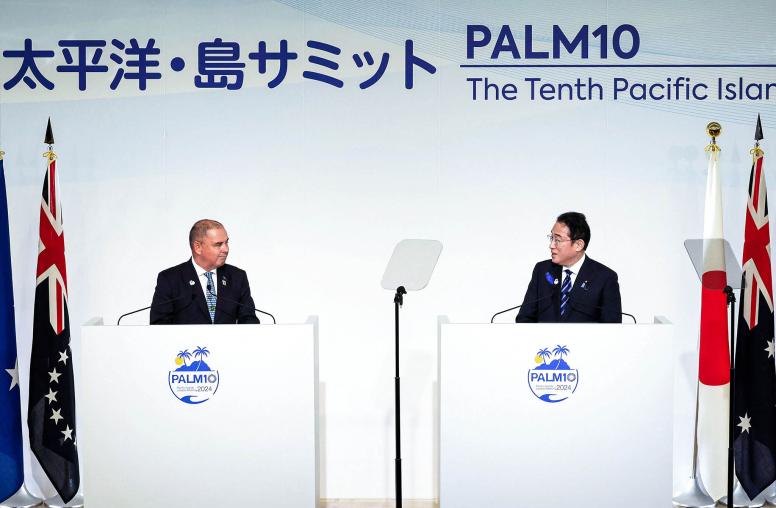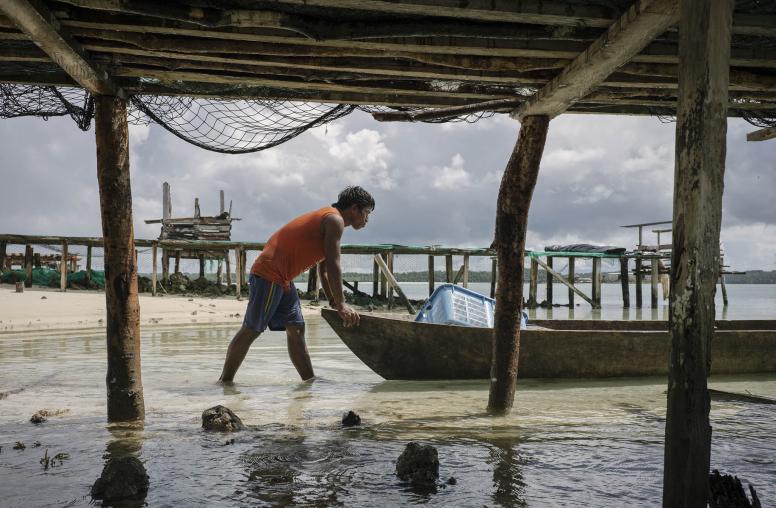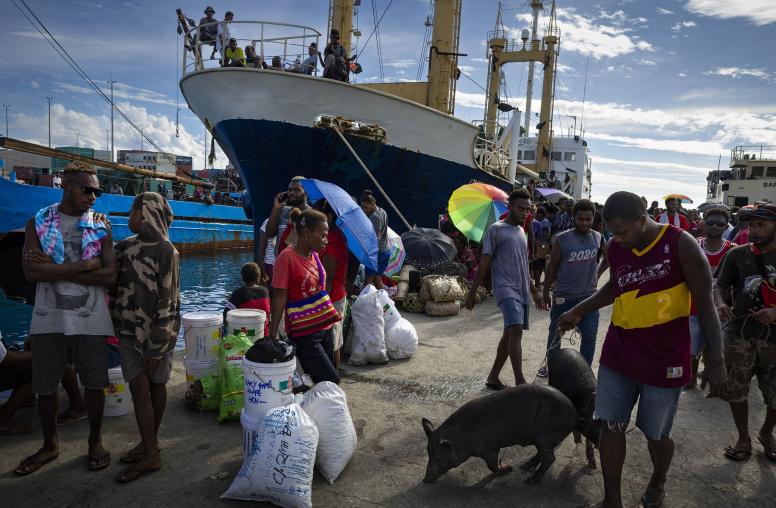Climate Change and Conflict in Solomon Islands
While climate security concerns are relatively new, Solomon Islands is no stranger to environmental changes.
Solomon Islanders are used to weather changes — so much so that oral histories of past disasters and environmental changes inform current responses. I remember listening to people in the town of Nea describe how a tsunami roughly 150 years ago showed a similar pattern as one that occurred in 2013, which meant they now knew where, when and how to evacuate based on Indigenous knowledge of history.

Solomon Islanders have also seen international migration caused, in part, by worsening environmental conditions. In the 1960s, British colonial leaders evacuated people from Phoenix Islands in Kiribati and resettled them in Solomon Islands after a drought, leading to vibrant communities of Micronesians in both Western Province and the nation’s capital.
However, climate change, with its current and projected effects, is placing further stress on individuals, communities and the country. And the unprecedented nature of these changes threatens to overwhelm the abilities of Solomon Islands’ government and social institutions to cope, leading to concerns for climate security.
Environmental Risks in Solomon Islands
Solomon Islands currently ranks as the second-most at-risk nation for natural disasters, in part because a high proportion (65 percent) of the population lives less than one kilometer from the sea. Rising sea levels also come with heightened risks of land loss and increased salinity of the water supply. Meanwhile, climate change is affecting marine habitats such as mangroves, river estuaries and coral reefs — a major concern, as 47 percent of all Solomon Island households rely on fishing or harvesting invertebrates for both food and income.
Meanwhile, migration is becoming a more prominent issue in Solomon Islands, as informal settlement limits options for communities to adapt and respond to climate change. For example, the Micronesian communities that were resettled in the 1960s were often not given formal ownership over their land. So when Kiribati communities around the town of Gizo were affected by a tsunami, they were told by aid agencies that their community buildings could not be built back with aid funds because they did not legally own the land, leaving them without proper infrastructure.
On many of the larger islands, such as Guadalcanal and Malaita, historical migrations featured people “coming down” from higher elevations to the seaside to access services at Christian missions and colonial stations. With climate change threatening sea-level territory, some of these people may have options to go “back up” to more inland or higher elevation areas inhabited by the same kin or cultural groups. While this amounts to displacement, it’s still a viable option to relocate at-risk communities to safety. However, there is no clear direction on where people who do not have links to inland areas should settle as sea levels continue to rise.
On the lower-level atolls, such as Malaita Outer Islands, environmentally induced hardships have already led to internal migration to local urban areas, as food can be scarce on these atoll islands. Low-lying islands may become entirely uninhabitable in the near future, as seawater intrusion and sea level rise, coupled with the islands’ remoteness from services and trade, slim down options for a secure livelihood.
For several generations, some communities across the country have taken to building artificial islands that are generally low-lying. But while they can continue to build sea walls from stones and coral around their homes, key sites such as graves are now being inundated with seawater, raising the risk for environmental crisis. Like the communities on atolls and those in coastal areas of the larger islands, there are questions about how people can continue to live on these islands if sea-level rise continues.
Dwindling Spaces for Migration
Eighty percent of land in Solomon Islands is owned by tribes. As a result, migration requires mediation and negotiation between different peoples — as well as the involvement of the government in the process of allocating land rights.
Right now, climate migration is primarily handled at the family or small clan level. People whose islands have become, or are on the cusp of becoming, unlivable currently find new housing among family- or tribal-owned lands, have it provided or partially subsidized by their employers, or squat on undeveloped lands in marginalized — and often also disaster-prone — urban and semi-urban areas.
A potential conflict factor is uncontrolled urban drift and informal settlement around Honiara and other towns. Urban areas are managed by the government but are generally overcrowded, with poor provision of services. Further migration to these areas can lead to resentment and even forced evictions.
These sort of tensions were a major feature of the low-level civil war in Solomon Islands from 1998-2003, where an estimated 20,000 people were evicted from Guadalcanal by Guale militants with grievances about migration from Malaita.
There have been a number of efforts by leaders in Guadalcanal and Malaita to reconcile and address those events. However, the national government’s response to calls to decentralize powers and put more control over land development in the hands of provincial leaders has been slow.
Troubles with Food Security
In the past, food security has been assured by the fact that most island households grow and harvest their own food. However, urbanization, destruction of land by logging and mining, increased exposure to disasters, changes in weather patterns, and the destruction of crops by introduced pests is reducing the amount and productivity of land available for food gardens.
During the COVID pandemic, the government instructed non-essential staff to go from Honiara to their rural villages and towns, with the expectation that they could fish and farm there. While most rural communities seem to have absorbed the increase in population and found ways to provide food, there were issues where the migration placed a strain on local populations, leading to instances of stealing food, breaking harvesting rules and rationing meals in order to survive.
Places that have practices of sustainable farming and fishing are generally better able to respond to the increased frequency of disasters in Solomon Islands and other shocks, such as the COVID pandemic.
However, in places of food scarcity and poverty — such as informal settlements where people have fewer options to produce their own food — and amid dwindling options for formal employment, theft and other petty crime are on the rise. This desperation also feeds other problems, such as illegal drugs and alcohol abuse, antisocial behavior, and violence against women and children.
Climate Finance, Aid and Adaptation
At the international and Pacific regional level, there have been increased commitments to finance and aid the fight against climate change, while many in Solomon Islands’ civil society have called for climate justice. So far, the impact of these funding commitments is difficult to gauge. Solomon Islands is the second-most impoverished nation in the Pacific. The median household income is just $3 per day. This, plus gaps in governance and service provision, makes it harder to respond to and be proactive about disasters and climate change.
Recently, carbon credit programs have provided cash transfers to local community members in return for forest conservation efforts. This allows for conservation to serve as a path toward economic growth while simultaneously discouraging communities from further mining and logging.
While these schemes hold promise, there are warning signs from Papua New Guinea that some partners for carbon trade do not gain informed consent and can be exploitative. Another key obstacle to these sorts of deals in Solomon Islands is that Indigenous land tenure is often not officially documented, meaning any land-use or carbon credit project must navigate a complex web of relationships to determine who the landowners are, as well as the appropriate tribal representatives, prior to even beginning their work.
Ideally though, project development should be accompanied by conflict resolution mechanisms so that carbon credit agreements can provide an alternative to logging and mining, which has wrought devastating results for both the people and environment in Renbel, Isabel, Malaita and Western Province.
While it’s true most local conflicts are handled by local leaders such as chiefs and religious leaders, land use agreements involve much more powerful players. Pressure from political leaders and some civil servants to accept mining, logging and other land-use deals proposed by companies can be intense, and communities often have a poor idea of what they are signing up for. Local communities need legal services to navigate these deals, and right now the only legal aid for landowners in the Solomon Islands, the Public Solicitors Office, has insufficient staff to meet needs.
When communities do manage to resist exploitative deals, it often involves support from either outsiders or wealthy Solomon Islanders that can fund lawyers to properly inform stakeholders about their rights and win cases.
The path toward food security is intimately linked with increasing the productivity of land and aquatic resources — as well as the peaceful settlement of disputes between and among tribes about their use.
However, there are options to build on local knowledge and practice. The Kastom Gaden Association and other local organizations currently spread knowledge about how to have sustainable and productive gardens, while traditions of local guardianship of fisheries are now being supplemented by information from government and civil society to support community-based fishery management at local levels.
In essence then, while much of the terminology around “climate security” feels new, many islanders feel as though they have been here before. Large migrations, disasters, environmental changes, sustainable management of natural resources and resolution of related conflicts are part of Solomon Islands history.
Options for food security, climate change adaptation, carbon offsetting and mitigation exist, as do traditions of conflict resolution among the country’s various peoples related to land use and migration. Governments, international finance institutions and development partners need to flip the focus from the new jargon to an older struggle: how to increase Indigenous knowledge, rights and agency over land, sea and related decisions. Doing so would allow Solomon Islands to transition from a country at high risk for climate change and natural resource-related conflicts to a more peaceful, resilient and sustainable future.
Anouk Ride is an adjunct senior fellow at the Solomon Islands National University and a fellow at Australian National University.



